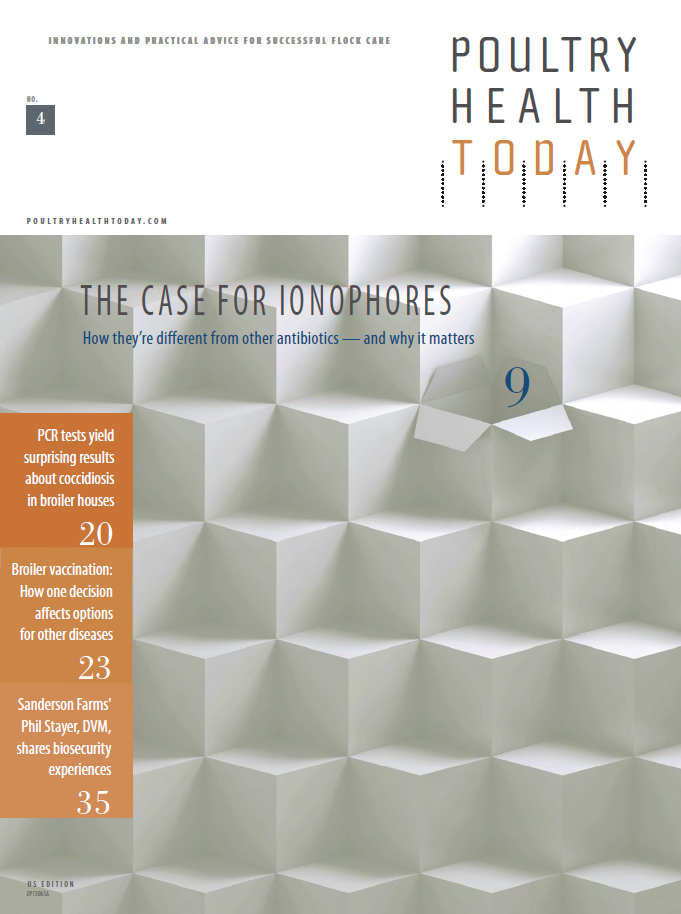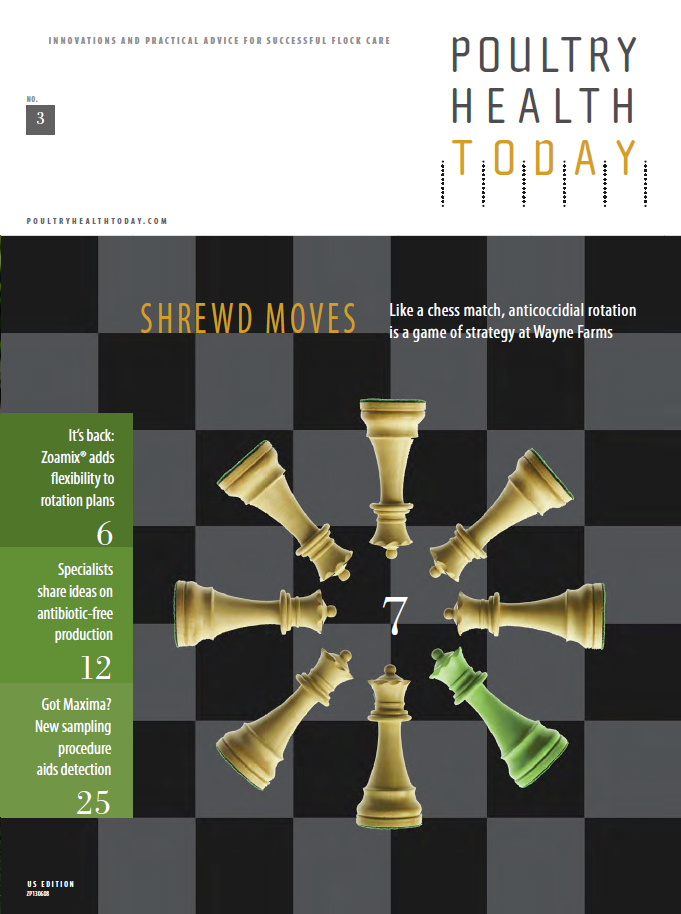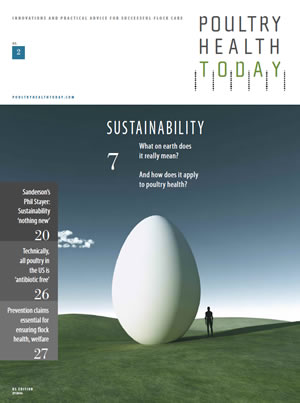

Prevention claims essential for ensuring flock health, welfare

"Prevention is when a veterinarian believes that a flock of chickens , for example , is at risk of being exposed and having an outbreak of a disease."William Flynn, DVM, MS, Center for veterinary medicine, FDA
New FDA guidelines that discourage using medically important antibiotics for promoting growth in food animals appear to have been well-received by both producers and most consumer activists.
Both groups agree that antibiotics should still be used judiciously to treat and control the spread of disease. However, some antibiotic hardliners object to the provision in FDA Guidance Document 213 allowing the continued use of any antibiotics for disease prevention — an option they see as a loophole to continue using them for growth promotion.
As one group, Food and Water Watch, posted in a recent blog, "Whether for growth promotion or disease prevention, the result is the same: This practice is creating more bacteria resistant to antibiotics that we need to protect human health."
The authors of the new FDA guidelines, which allow certain non-medically important antibiotics to retain performance claims, apparently don't share that view. Nevertheless, such statements underscore the continued need for veterinarians to explain and defend the judicious use of antibiotics for preventing certain diseases in food animals.
Chickens 'at risk'
William Flynn, DVM, MS, deputy director for science policy, Center for Veterinary Medicine, FDA, insists the FDA does not condone the willy-nilly use of antibiotics for preventing disease.
"Disease prevention is not the use of drugs to prevent whatever disease might come along. That's not at all what we're talking about here. We wouldn't consider that judicious use," Flynn explains.
"Prevention is when a veterinarian believes that a flock of chickens, for example, is at risk of being exposed and having an outbreak of a disease. Based on that risk, [the veterinarian makes] the decision that preventive administration of an antibiotic is warranted to prevent the outbreak. There's knowledge and experience that goes into that decision," Flynn says.
Furthermore, he points out that the new FDA guidelines will further increase the involvement of veterinarians when antibiotics are used in food animals.
Animal suffering and death
G. Donald Ritter, DVM, director of health services for Mountaire Farms, a major poultry producer based in Millsboro, Del., points out that using some antibiotics, including ionophores, to prevent disease is crucial to protect animals from needless suffering and death.
In poultry, Ritter says, the most salient example of how preventive antibiotics are used involves clostridial enteritis and coccidiosis, two common diseases of the intestines that often appear together. Enteritis is caused by the bacterium Clostridium perfringens and usually occurs while chickens are battling coccidiosis.
It is widely known that coccidia — the parasites that cause coccidiosis — are persistent and that eradicating them from the poultry-house environment is difficult, if not impossible. When coccidia go through their life cycle, Ritter explains, they cause a bacterial imbalance in the gut that results in excess mucus production. The mucus provides food for C. perfringens, which is a widely prevalent bacterium found in soil, dust, feces, feed and litter.
If there is no intervention and clostridium is allowed to proliferate, tissues in the gut start to die, resulting in the condition known as necrotic enteritis. Chickens suffer and an intense regimen of therapeutic antibiotics is required. Mortality can be as high as 50%.
To prevent this chain of events, poultry veterinarians generally recommend using one of three FDA-approved antibiotics — bacitracin, bambermycins or virginiamycin — to prevent necrotic enteritis from infecting the flock, Ritter explains.
"We're going to use the least amount of antibiotics at targeted times to prevent and control — and hopefully not treat — disease. We're trying to prevent illness and death from clostridial enteritis before they occur. This is where prevention and control of disease is of paramount importance to a successful poultry-health and welfare program. Waiting for birds to get sick is not what veterinarians want to do," he says.
Ritter notes that he's worked extensively with alternatives to antibiotics and that the results have been less than stellar for managing necrotic enteritis.
"The alternatives look good in studies but just don't act the same way in the field. There are no standards for them and many lack quality control. When we use something that is not FDA regulated, it's the wild, wild West," he says.
Healthy meat
There's another important reason for using antibiotics to prevent disease outbreaks in poultry: Healthy chickens provide healthy meat, Ritter says.
In his experience, flocks raised without antibiotics have a higher rate of clostridial enteritis infections and necrotic enteritis, higher mortality and a higher rate of condemnation at processing than flocks that received antibiotics.

"Waiting for birds to get sick is not what veterinarians want to do"
G. Donald Ritter, DVM, Mountaire Farms
The late Scott Hurd, DVM, PhD, the well-known veterinarian from Iowa State University who became an industry proponent of judicious antibiotic use and food safety, maintained that antibiotic-free-animals could potentially pose a greater risk to human health.
"Pathogens are a common, unavoidable part of any environment. Disease prevention is important for keeping animals healthy in such an environment. In the absence of effective prevention, animals face greater health challenges that may lead to marginally healthy animals or subclinical illness," Hurd posted in his hurdhealth.com blog last year.
"My research has shown that subclinical illness is not outwardly obvious to the producer or inspector but puts animals at risk for carrying increased levels of bacteria responsible for foodborne illness, such as Campylobacter and Salmonella," Hurd wrote.
Consumer Education
Ritter emphasizes the need to educate consumers about when antibiotics for food animals are needed and how healthy meat is produced.
"Issues involving the use of antibiotics in food animals is in the newspapers, on the Internet and it's a major concern for some of our customers. Many poultry companies, especially those that are branded, are already involving veterinarians by having them talk to customers. It's critical that the antibiotic discussion is complete and transparent," he says.
Customers need to understand that the antibiotics used for gut health are not in the meat they buy and that flocks need to be kept healthy to produce healthy meat, he adds. (See Reality Check, page 26.)
"If you explain this to customers, they really understand. [They] would rather buy meat from healthy chickens instead of from flocks that didn't receive antibiotics and are not as healthy. That's generally the outcome if the discussion is thorough," Ritter says.
More Issues















